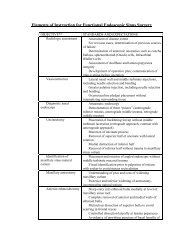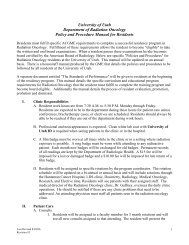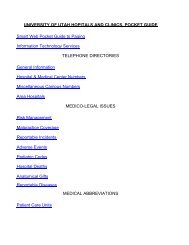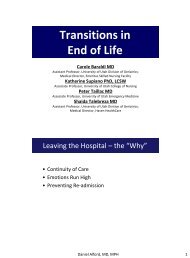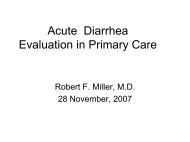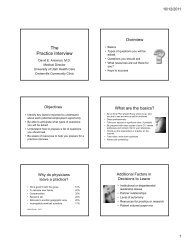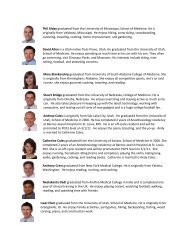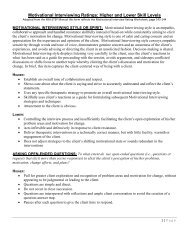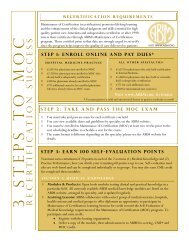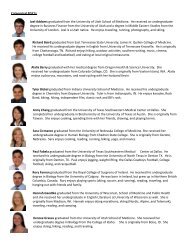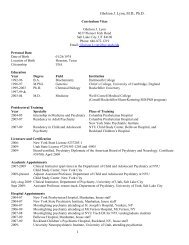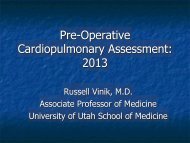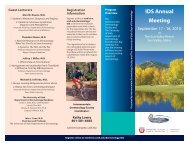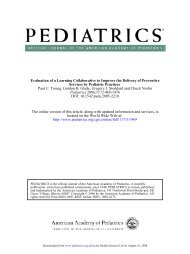Winter 2008/2009 - University of Utah - School of Medicine
Winter 2008/2009 - University of Utah - School of Medicine
Winter 2008/2009 - University of Utah - School of Medicine
Create successful ePaper yourself
Turn your PDF publications into a flip-book with our unique Google optimized e-Paper software.
Mark A. Johnston, M.D., 1990<br />
I recall thinking that each <strong>of</strong> these<br />
individuals had directly helped literally<br />
thousands <strong>of</strong> patients during their<br />
careers and that the cumulative service<br />
<strong>of</strong> this one medical school class was truly<br />
remarkable. In a time when language<br />
is characterized by hyperbole and style<br />
seems <strong>of</strong>ten to be more important than<br />
substance, witnessing this ceremony was<br />
both an inspiration and a reminder <strong>of</strong><br />
the importance <strong>of</strong> committing oneself to<br />
activities <strong>of</strong> true value.<br />
Organizations, like individuals,<br />
face decisions about their priorities and<br />
commitments. Alumni associations in<br />
particular must be concerned about<br />
whether their activities meaningfully<br />
serve the needs <strong>of</strong> alumni, students and<br />
their institution.<br />
Being asked in 1990 by Dean<br />
Samuelson to serve on the newly formed<br />
Alumni Board for the <strong>School</strong> <strong>of</strong><br />
2<br />
Alumni President’s Message<br />
It was my great pleasure this past September to attend<br />
the awards ceremony honoring the <strong>University</strong> <strong>of</strong> <strong>Utah</strong> <strong>School</strong> <strong>of</strong><br />
<strong>Medicine</strong> graduates from the Class <strong>of</strong> 1958. It was wonderful to hear<br />
a recounting <strong>of</strong> the pr<strong>of</strong>essional and personal accomplishments <strong>of</strong> these<br />
50-year graduates.<br />
<strong>Medicine</strong>, I have had a special opportunity<br />
over nearly 20 years to witness<br />
the commitments and priorities <strong>of</strong><br />
the <strong>University</strong> <strong>of</strong> <strong>Utah</strong> SOM Alumni<br />
Association and to gauge its growth. In<br />
the earliest days, there were no full-time<br />
staff members, no student programs,<br />
no alumni services, no CME programs,<br />
no Web site and no regular newsletter<br />
to connect alumni. There was, however,<br />
a vision that the Association should be<br />
committed to creating specific services.<br />
There was also a remarkable succession<br />
<strong>of</strong> physicians who volunteered their<br />
time to bring about the many programs<br />
and resources that now characterize the<br />
organization.<br />
With an ongoing commitment to<br />
improving the programs and services<br />
provided by the Alumni Association, a<br />
strategic planning initiative was begun<br />
in early <strong>2008</strong>. A variety <strong>of</strong> new programs<br />
and program enhancements are<br />
in the <strong>of</strong>fing including an expansion <strong>of</strong><br />
web services to connect alumni with<br />
classmates, streaming <strong>of</strong> CME and<br />
Grand Rounds programs, and an expansion<br />
<strong>of</strong> the HOST program for students<br />
to connect them with Alumni through-<br />
out the nation. We are also considering<br />
programs to improve our connection<br />
and service to house staff who train at<br />
the <strong>University</strong> <strong>of</strong> <strong>Utah</strong>.<br />
As always, we encourage your<br />
contact with us and any suggestions<br />
you have on how we might better serve<br />
our mission to support the <strong>School</strong> <strong>of</strong><br />
<strong>Medicine</strong>, alumni, faculty and students.<br />
Mark A. Johnston, M.D., 1990<br />
President, Alumni Board<br />
<strong>University</strong> <strong>of</strong> <strong>Utah</strong> <strong>School</strong> <strong>of</strong> <strong>Medicine</strong><br />
jmresearch@qwest.net<br />
Penicillin, Miracle Drug <strong>of</strong> the<br />
Century, Herald <strong>of</strong> a New Era<br />
George Gee Jackson, M.D. ‘47, Pr<strong>of</strong>essor <strong>of</strong> <strong>Medicine</strong> Emeritus<br />
INTRODUCTION<br />
The Twentieth Century was a period <strong>of</strong><br />
remarkable progress in medical education,<br />
knowledge, objective diagnosis<br />
and miracle products and procedures<br />
that completely changed the nature <strong>of</strong><br />
hospitals and the practice <strong>of</strong> medicine.<br />
First and paramount among them was<br />
the discovery <strong>of</strong> penicillin, christened<br />
in the press as the miracle drug <strong>of</strong> the<br />
century. The achievement was paramount<br />
as a force changing the discipline<br />
<strong>of</strong> medicine because it immediately<br />
salvaged innumerable lives by the cure<br />
<strong>of</strong> prevalent acute and chronic infectious<br />
diseases. In addition, its development,<br />
which initiated discovery <strong>of</strong> the series<br />
<strong>of</strong> natural molecules with antibiotic<br />
activity, enabled some <strong>of</strong> the most miraculous<br />
landmark achievements <strong>of</strong> the<br />
latter half <strong>of</strong> the 20th Century—organ<br />
transplantation, insertion <strong>of</strong> synthetic<br />
joints and prostheses, invasive diagnostic<br />
and radical surgical procedures, immunosuppressive<br />
chemotherapy, selective<br />
gene replacement, in vitro tissue, organ<br />
cultures and others.<br />
Coupled with the carryover contributions<br />
from the 19th century—ether<br />
anesthesia, opiates, foxglove and early<br />
vaccines, and turn <strong>of</strong> the Century,<br />
X-ray images, the art <strong>of</strong> medical practice<br />
progressively transitioned to the art and<br />
science <strong>of</strong> medicine. The discovery <strong>of</strong><br />
penicillin was the herald <strong>of</strong> things to<br />
follow. The accessible house call physician<br />
and large charity hospitals with<br />
a high proportion <strong>of</strong> beds for people<br />
with infections transitioned to a more<br />
science based discipline, specialization<br />
and smaller private hospitals. Life<br />
expectancy increased dramatically and<br />
concomitantly diseases associated with<br />
aging—cancer, type 2 diabetes, and<br />
chronic degenerative diseases increased<br />
proportionately. Accuracy <strong>of</strong> diagnosis,<br />
vastly better understanding <strong>of</strong> pathophysiology<br />
and increasing ability to intervene<br />
with specific treatment validated<br />
in double blind clinical investigations<br />
characterized the changes. Many believe<br />
the last half <strong>of</strong> the 20th Century was<br />
the golden age <strong>of</strong> medicine; combining<br />
the art <strong>of</strong> the personal, caring, compassionate,<br />
wise physician counselor with<br />
time to spend with the patient and the<br />
knowledge and technology developed in<br />
the science <strong>of</strong> medicine.<br />
THE SERENDIPIDITY<br />
OF DISCOVERY BY THE<br />
PREPARED MIND<br />
In 1928 Sir Alexander Fleming was a<br />
47 year old physician lecturer <strong>of</strong> Scotch<br />
birth working at St. Mary’s Medical<br />
<strong>School</strong> <strong>of</strong> London <strong>University</strong>. His research<br />
focus was on the properties <strong>of</strong> the<br />
staphylococcus and the effects <strong>of</strong> natural<br />
products <strong>of</strong> the body that inhibited<br />
and/or killed it. Of particular interest<br />
was the cellular production <strong>of</strong> lysozyme.<br />
Agar plates were seeded with a lawn<br />
<strong>of</strong> hemolytic Staphylococcus aureus and<br />
its growth, or lack there<strong>of</strong>, observed in<br />
relation to exposure to various products.<br />
Sir Fleming was not known to keep<br />
an overly tidy lab; a fortuitous feature in<br />
the discovery <strong>of</strong> penicillin. Returning<br />
from a long holiday many petri plates<br />
used in a forgotten experiment were<br />
found to be contaminated with mold.<br />
They were discarded to be disinfected.<br />
However, it is reported that some <strong>of</strong><br />
them were retrieved for a discussion <strong>of</strong><br />
his work with a visitor to the laboratory.<br />
The lack <strong>of</strong> bacterial growth around a<br />
contaminating mold on one or more<br />
<strong>of</strong> the plates was the observation that<br />
piqued the curiosity <strong>of</strong> an inquisitive<br />
3



